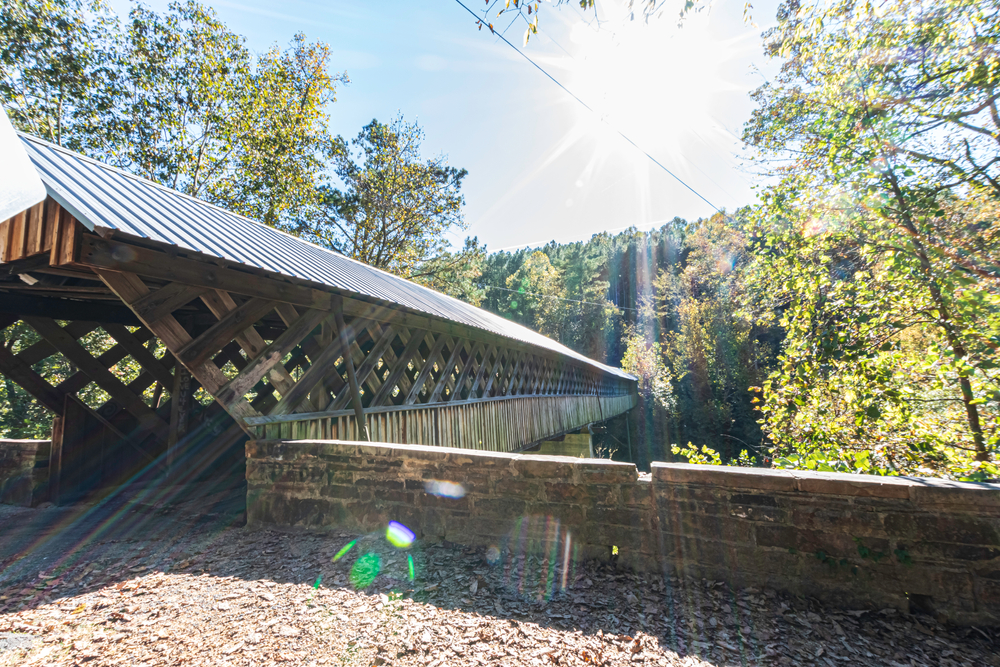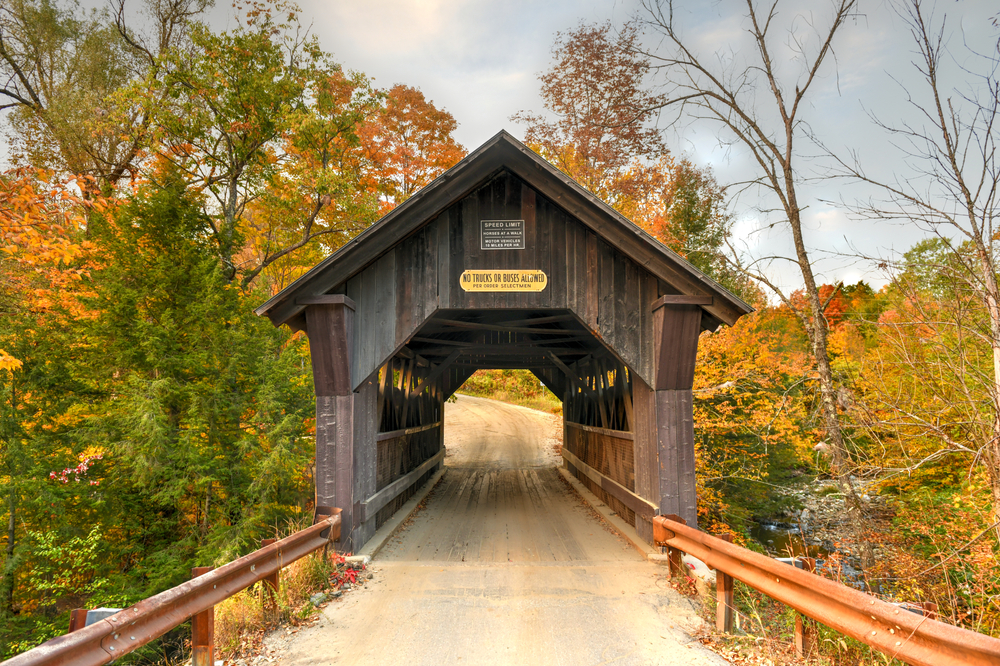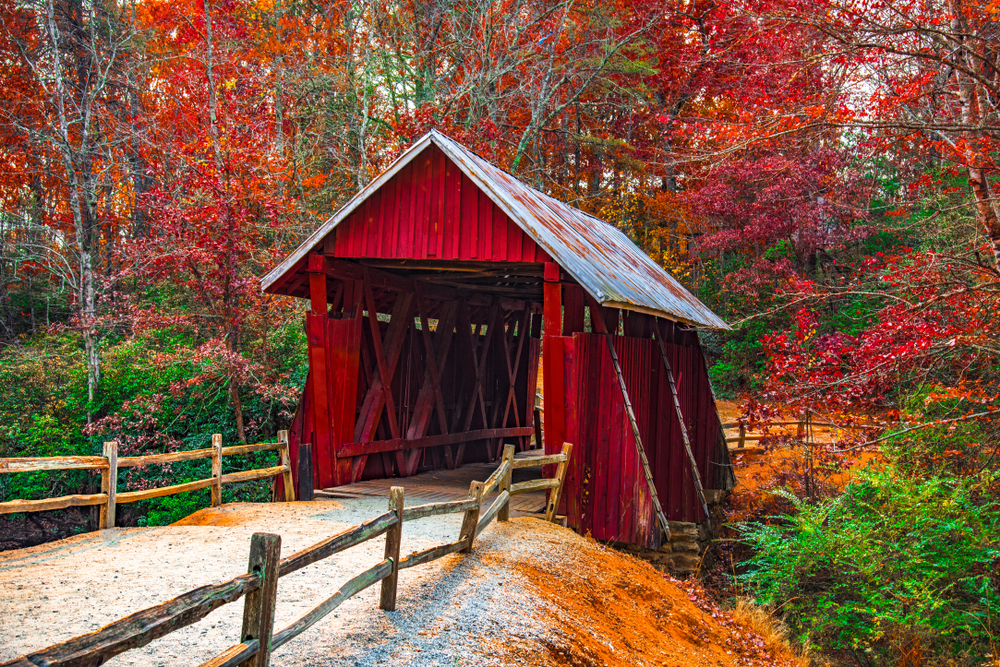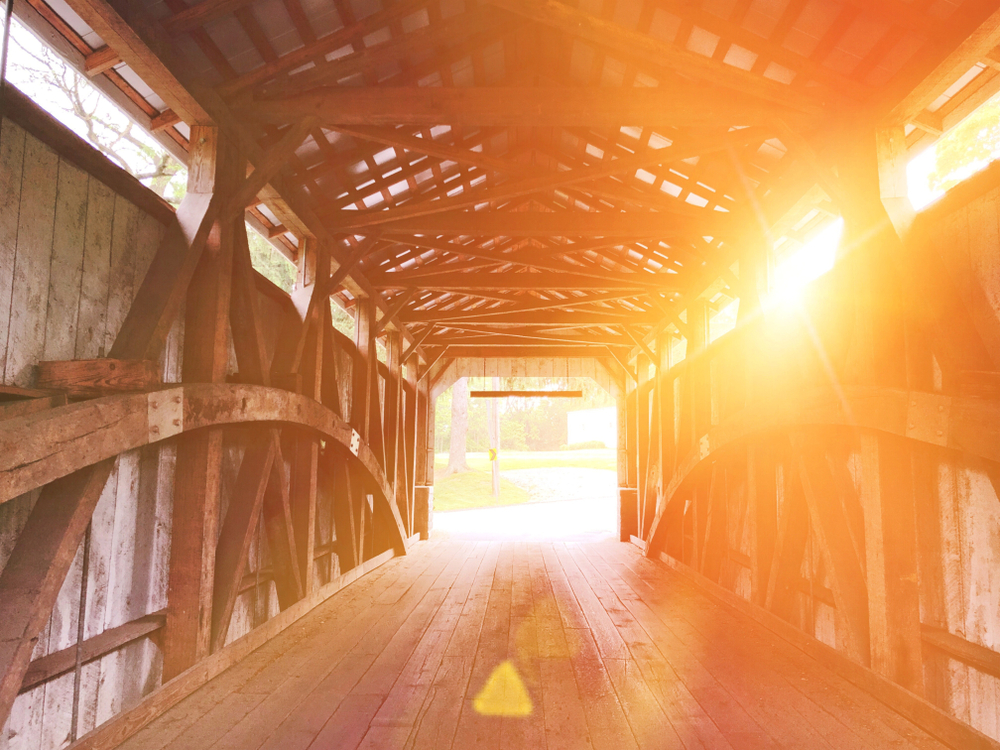These historic covered bridges will take you back in time!
The use of covered bridges in the United States of America goes all the way back to the early 1800s when they were part of the nation’s infrastructure.
And even though covered bridges aren’t exactly a standard nowadays, a few remain in the country that are many years old.
These historic covered bridges are a reminder of the past and provide a glimpse into the engineering creativity of our ancestors. The oldest in America range from California to New York and offer a unique experience for modern-day tourists.
These structures are a reminder of the past and a testament to the resilience of bridges and the people who built them. So, on that note, follow along as I explore the 23 most historic covered bridges in the United States!
… Psst: Can you guess which of our US states has the MOST historic covered bridges?

Horton Mill Bridge, Oneonta, Alabama
Not to be confused with the bridge with a similar name in the state of Wisconsin, this bridge is one of the highest historic covered bridges in the nation, standing 70ft above the Black Warrior River. It’s one of 3 covered bridges in Alabama’s Blount County.
The 203ft-long bridge was constructed in 1934 and underwent rehabilitation in 1974 and then again in 2013. This historic covered bridge is named like that for Talmedge Horton, one of the people that built it and part of a local gristmilling lineage.
Stunning latticework adorns the sides of the bridge, allowing for theatrical views down into the river gorge.
Stark Bridge, Stark, New Hampshire
This won’t surprise you, but covered bridges attract photographers, artists, and history enthusiasts.
So when there was whispers of replacing the bridge that transited New Hampshire’s Upper Ammonoosuc River with a glossy new steel bridge in the 50s, public outcry was so great that it convinced the residents of Stark they had a landmark that was worth restoring.
This bridge had already experienced an eventful past. It was constructed in 1862 but washed away during floods by the end of the century. Stronger stone foundations were installed after the historic covered bridge was retrieved and put back in place.
Further structural issues in the 1940s led locals to suggest replacements in the 50s. Still, ultimately, the state helped to fund repairs and restoration, and the bridge is now considered one of the loveliest in the nation.
Goodpasture Bridge, Vida, Oregon
The Goodpasture Bridge, which stretches 165ft across the McKenzie River, differs from other wooden and historic covered bridges because of its straightforward design feature: It has windows. Each side of the bridge features a whopping 10 Gothic-style louvered windows that give the bridge a unique flair.
Constructed in 1938 and named after a local farmer, Goodpasture is the state of Oregon’s 2nd longest covered bridge.
The state has fought replacing it with a steel span, but rather opted to invest in a $2 million reinforcement and overhaul that added LED lighting for dazzling night views. And at Christmas time, the white bridge is decked out in various seasonal colors.
Newfield Covered Bridge, Newfield, Maine
The Newfield Covered Bridge is a magical historic wooden covered bridge that spans the Warner River. Created in 1851, the bridge is one of the oldest surviving bridges of its kind in the state of Main and is even listed on the National Register of Historic Places.
It’s made of stone and wood, with two stone pillars at each end and a wooden deck. At just over 115ft long, the Newfield Covered Bridge is a spectacular sight as it crosses the river. It’s also well-known for its arched design, which allows the structure to be more stable under the weight of vehicles, in the face of strong winds, and if flooding occurs.
Besides this, this historic covered bridge has survived several floods and fires, including a devastating fire in the 40s that obliterated its superstructure but left its stone pillars untouched. The bridge also has a distinctive history of being used as a covered bridge until 1912, when a metal bridge replaced it.
Colville Covered Bridge, Paris, Kentucky
The Colville Bridge has distinctive white and green stripes and is one of 13 covered bridges left in the state of Kentucky. The 124ft bridge was constructed from yellow poplar back in 1877 to cross Hinkston Creek. In 1937, this historic covered bridge was raised to help shield it from flooding in the creek.
But sadly, record flooding 60 years later saw water levels rise a few feet above the bridge’s decking, causing it to move off the road. After careful renovations and repairs, it’s once again open to vehicles driving through.
A popular site with local shutterbugs, the Colville Bridge is also believed to be haunted by numerous spirits.
Cornish-Windsor Bridge, Windsor, Vermont, and Cornish, New Hampshire
Linking the two towns in its name, the Cornish-Windsor Bridge also happens to link two states. Cornish is located on one bank of the Connecticut River in New Hampshire, and Windsor is on the other in Vermont.
When it was constructed in 1866, it became the 4th bridge to cross this site after earlier crossings had been washed away by flooding. The state of New Hampshire bought the bridge in 1935 and operated it for a while as a toll route.
During Vermont’s time as a dry state, when liquor sales were prohibited, this historic covered bridge was a convenient means for thirsty locals to purchase alcohol where it was still legal in New Hampshire.
While that’s no longer an issue nowadays, you’ll have to remember to follow the advice at the bridge entrance: “Walk your horses or pay a two-dollar fine!”
Windsor Mills Covered Bridge, Ashtabula County, Ohio
The Windsor Mills Covered Bridge happens to be one of the only remaining historic covered bridges in Ohio, and it acts as a reminder of a different period in American history. The bridge’s design, featuring a town lattice truss, is a testament to the creativity of the builders of the past.
The covered bridge’s design protected the wooden trusses from the elements and added to the structure’s aesthetic charm. Its length of 120ft makes it a relatively long historic covered bridge, and it spans the Little Beaver Creek, joining the two sides of Ashtabula County in Ohio.
Its siding and gabled roof give it a quaint and charming appearance that visitors find adorable. It’s a cherished symbol of Ohio’s rich heritage and history, and a testament to the ingenuity and perseverance of the state’s early migrants.
Nowadays, the Windsor Mills Covered Bridge is a popular tourist hotspot, attracting travelers from all over Ohio and beyond.
Elizabethton Covered Bridge, Elizabethton, Tennessee
Perched on the Doe River, the Elizabethton Covered Bridge was finalized in 1882. Colonel Thomas Matson, who had devised the idea for New York’s elevated railroad tracks, created the bridge, which was thought of as an engineering marvel at the time.
It lived up to its reputation in 1901, though, when a flood eliminated all the area’s other bridges on the river. Situated in Elizabethton’s downtown area, the bridge is now part of the city park, and there are quite a few events that are based around the landmark, such as the Covered Bridge Days Festival, which takes place in September.
The residents are proud of the gleaming white bridge, and I don’t blame them.

Gold Brook Covered Bridge, Stowe, Vermont
The Gold Brook Covered Bridge is among the most iconic and historic covered bridges in the United States of America. It stands as a reminder of a different era located in the stunning area of Stowe. Constructed in 1844, it spans a length of a whopping 49ft.
It was originally built as a toll bridge, but the tolls were ultimately abolished in 1889. The Gold Brook Covered Bridge happens to be the only two-span covered bridge in the entire world that’s still actively used. A curved wooden roof shields its wooden sides, and two massive stone pillars sustain its trusses.
It was also the first covered bridge in the US to be created with steel nails rather than wooden pegs. And it’s also on the National Register of Historic Places and is even a major tourist destination.
Felton Covered Bridge, Felton, California
The most elevated covered bridge in the country is the Felton Covered Bridge in the Sunshine State. Nowadays, part of a park system in Santa Cruz County, this historic covered bridge is only open to pedestrians. Strolling through it, you can look up to appreciate its 35ft height and its detailed criss-cross roof design.
The bridge was finished in 1893 and, for many years, was the only route into the charming town of Felton. After it closed to vehicular traffic in the 30s, it became a popular landmark and was included to the National Register of Historic Places in 1973.
Mechanicsville Road Bridge, Ashtabula County, Ohio
The Mechanicsville Road Bridge is another historic covered bridge in Ashtabula County, Ohio, US. Built in 1867, it was designed by the famous covered bridge builder J.J. Daniels. Measuring 156ft in length, this stunning bridge is a Burr Arch Truss design, which is characterized by its numerous arches and vertical compression members.
Its intricate design showcases the ingenuity and craftsmanship of past builders. Nowadays, the Mechanicsville Road Bridge is a popular tourist destination, open exclusively to pedestrian traffic, and it’s even documented on the National Register of Historic Places.
Fun Fact: The Mechanicsville Road Bridge initially served as a crossing over the Wapsinonoc Creek.
Silk Road Covered Bridge, Bennington, Vermont
The Silk Road Covered Bridge is a beautiful historic wooden bridge in Bennington, Vermont. It’s the state’s only surviving historic covered bridge and was built in 1840. The bridge itself is more than 85ft long and has a distinctive roof style.
The sides are framed in a series of horizontal planks and vertical posts, giving the bridge an incredibly iconic look. This historic covered bridge is open to vehicular traffic, and pedestrians can still walk across it and admire its magnificence.
And even though it has seen many repairs throughout the years, it’s now in excellent condition. It’s even listed on the National Register of Historic Places and is regarded as one of the most important historic covered bridges in the United States of America.
Fun Fact: The Silk Road Covered Bridge is the longest historic covered bridge in Vermont.
Roseman Covered Bridge, Winterset, Iowa
The picturesque covered bridges of Iowa have become famous worldwide due to Robert James Waller’s book The Bridges of Madison County and the 1995 film of the same name. Nowadays, the well-known county has 6 covered bridges still standing.
The most renowned is the Roseman Covered Bridge, a.k.a. the Oak Grove Bridge. Constructed in 1883, this covered bridge measures 225ft long. Along with being associated with Meryl Streep and Clint Eastwood, the eye-catching red bridge with sparkling white rails has a haunted reputation among its locals.
According to fables, the bridge’s name came from an 1892 chase involving a sheriff’s crew and a man who seemingly rose straight through the bridge’s roof and disappeared into thin air.
Hutchins Covered Bridge, Montgomery, Vermont
The Hutchins Covered Bridge is a historic covered bridge made of wood in Montgomery, Vermont. It was constructed sometime in the late 1865. The bridge spans Thomas Creek and is 77 feet long. Hutchins Covered Bridge was created using the Town lattice truss design, a highly cost-effective and efficient method of spanning rivers and streams.
The sides and covered roof of this bridge were included to protect the wooden trusses from the elements, extending the structure’s life. The Hutchins Covered Bridge is also thought of as a remarkable example of American engineering and construction, reflecting the ingenuity and resourcefulness of its frontiersperson.
FYI: Hutchins Covered Bridge can be found on the National Register of Historic Places and is a popular tourist destination in Linn County.
Humpback Bridge, Covington, Virginia
Virginia’s Allegheny County is home to an 100-foot-long historic covered bridge that’s significant for two reasons. It’s the state’s oldest and boasts an impressive arched shape, with its center point several feet higher than either end.
Before the Humpback Bridge was positioned here, 3 other ill-fated covered bridges were at this site on Dunlap Creek. But floods flushed away the first two, and the third crumpled.
Luckily, the 4th version, constructed in 1857, is still standing strong, and its designers, who thought the arch shape would offer much better protection from flooding, were correct in their judgment.
After a steel bridge was made nearby in 1929, traffic over the bridge was suspended, and a local farmer used the bridge for storage. But a local women’s group raised funds for its rehabilitation in the 50s, and the bridge reopened to the public as part of a park.
Halpin Covered Bridge, Middlebury, Vermont
The Halpin Covered Bridge is a historic landmark in Middlebury. Constructed in 1824, it’s one of the state of Vermont’s oldest remaining covered bridges and was included to the National Register of Historic Places in the 70s. This covered bridge is about 66 feet long with a unique truss system made of hefty wooden beams.
It’s covered with wooden planks, which also gives it a rustic, picturesque appearance. The Halpin Covered Bridge has actually been the subject of many stories, songs, and photographs. It was anointed after the local Halpin family, who constructed the bridge to cross the South Fork of the Chariton River.
It has been comprehensively restored several times, with the last major renovation project completed as late as 2006. Fun Fact: It’s open to visitors and is a popular spot for picnics, photography, and fishing.

Campbell’s Bridge, Landrum, South Carolina
Campbell’s Bridge might just be a mere 35 feet long, but it’s a state treasure as the only historic covered bridge that’s still standing in South Carolina. A local builder named Charles Irwin Willis created the bridge across Beaverdam Creek and called it after the then-landowner Lafayette Campbell.
The red wood-and-iron bridge was a beneficial addition to the local community. Why? Well, trips that had once taken an entire day to complete could now be made in little over an hour.
Greenville County now owns Campbell’s Covered Bridge and is situated on public parkland, although it has been closed to vehicle traffic since 1980.
Jackson Covered Bridge, Parke, Indiana
The Jackson Covered Bridge is a historically meaningful wooden bridge in Parke. Built in 1861, it remains one of the few historic covered bridges in the entire state of Indiana.
Traveling across Jackson Creek, the bridge measures at 225 feet. It’s regarded as a remarkable demonstration of American construction and engineering and reflects the resourcefulness and ingenuity of its pioneers. Visitors can cross the bridge and capture some beautiful pics, as well as gain a better understanding of the American history of covered bridges.
The bridge is also a popular platform for events such as picnics and weddings, and is a treasured part of the local community.
Fun Fact: Jackson Covered Bridge is a testament to the state’s prosperous history and is an adorable representation of American heritage that continues to draw visitors across the nation.
Sachs Covered Bridge, Gettysburg, Pennsylvania
Did you know that Pennsylvania has 213 covered bridges? That’s more than any other state! Sachs Covered Bridge was constructed in 1852 for residents to be able to cross Marsh Creek, just outside Gettysburg, and it measures about 100ft long.
A little over ten years after its construction, its site meant that it would serve as a shelter for both Union and Confederate troops during the key three-day battle. In 1938, the Department of Highways anointed Sachs Bridge the state’s “most historic bridge.”
This covered bridge was open to pedestrians and vehicles in the past. Yet, due to preservation efforts and concerns about its solidity, it’s now open only to pedestrians.
Pulp Mill Covered Bridge, Middlebury, Vermont
The Pulp Mill Covered Bridge is another iconic design located in charming Middlebury. The bridge was constructed in 1808 and is well-known as the most historic covered bridge in the United States of America.
It’s also one of the area’s most iconic and photographed structures, and its distinctive design has been featured in a couple of TV shows and movies. At a mere 199 feet, the Pulp Mill Covered Bridge spans a waterway that was once used to transport logs to nearby paper and pulp mills.
6 wooden trusses support the bridge and feature a remarkable design that allows it to remain open and accessible to both pedestrian and vehicle traffic.
Fun Fact: This covered bridge has been well-maintained over the years and has been able to withstand the rough winter temperatures of the region.
Oregon Creek Covered Bridge, Yuba County, California
The Oregon Creek Covered Bridge is another interesting historic structure in Oregon House, Yuba County, California.
Constructed in 1860, the bridge is a single-span timber Howe truss design measuring more than 100 feet, and is the oldest remaining covered bridge in the state of California and one of just a few of surviving covered bridges in the western United States of America.
This historic covered bridge was welcomed to the National Register of Historic Places in ’71 and was declared a California Historical Landmark in 1975. The bridge is a perfect example of the exceptional engineering and craftsmanship of the nineteenth century.
It’s a must-see for anyone who is interested in the culture and history of the area. Interestingly, this bridge was acknowledged as an American Society of Civil Engineers Historic Civil Landmark back in 1978.
Red Covered Bridge, Princeton, Illinois
The sign that’s painted about the Red Covered Bridge in Princeton is a major throwback to what life was like when it was first constructed in 1863. It reads, “5 dollars fine for driving more than twelve mules, horses, or cattle at one time or for leading any beast faster than a walk on or across this bridge.”
The Red Covered Bridge, situated roughly two hours away from Chicago, is not only the oldest but also the longest historic covered bridge in the entire state of Illinois.
It’s also still open to traffic, although these days that means cars rather than cattle or mules. Created from stone and wood, it measures just under 150 feet in length and cost a bout $3,000 to build, which is equivalent to approximately $65,000 today.
Halpin Covered Bridge, Middlebury, Vermont
The Halpin Covered Bridge is a historic landmark in Middlebury. Built in 1824, it’s one of this state’s oldest covered bridges still standing and was included in the National Register of Historic Places sometime in the 70s. This covered bridge is approximately 66 feet long with a striking truss system of hefty wooden beams.
It’s shielded in wooden planks, which also gives it a picturesque, rustic appearance. This particular covered bridge has been the subject of many songs, stories, and photographs.
It was named after the local Halpin family, who constructed the bridge to cross the South Fork of the Chariton River. It has been comprehensively restored many times over the years, with the last major renovation project finished in 2006.
Fun Fact: It’s open to visitors and is a popular spot for picnics, photography, and fishing.

Bonus: Tips for visiting these historic covered bridges
It doesn’t matter if you’re a seasoned traveler or a first-time visitor. Having some tips for exploring the beautiful and historic covered bridges that dot our country is always helpful.
In this bonus section, I’ll provide photography tips, some tips on the best seasons to visit, and safety and etiquette guidelines to ensure your historic covered bridge adventure is as memorable and enjoyable as possible.
The best time to see a historic covered bridge is generally in the spring or fall, when the weather is milder and the foliage is most lively. For shutterbugs, the best light is usually in the early morning or late afternoon.
- Photography tips: When taking pics of historic covered bridges, consider the lighting and environment to enhance your pictures. As I mentioned, the most optimal times for photography are usually early morning and late afternoon when the light is warm and soft. Try to experiment with various perspectives and angles to grasp the essence of the historic covered bridge and its surroundings. Try snapping from a lower viewpoint to encapsulate the aura and magnitude of these landmark structures. And always remember to enjoy the process because each bridge is unique in its own right and offers rewards and challenges.
- Best time to visit: The best seasons to visit historic covered bridges are spring and fall. But summers aren’t bad either. During these times, the weather is generally mild, and the surrounding terrains are at their most picturesque and vibrant. In the spring, you’ll find the countryside teeming with color as flowers begin to bloom, while summer offers leisurely bike rides and strolls in the warm sunshine. Fall brings a spectacular foliage display, providing a stunning backdrop for your historic covered bridge exploration. But no matter the season you choose to go on your adventure, visiting these landmark structures will surely be an unforgettable experience.
- Safety and etiquette: When visiting historic covered bridges, respecting the structures and their surroundings is vital. These historical landmarks are usually delicate and require care to preserve them for generations to come. So make sure you follow all local laws and posted signs, and never deface or climb on the historic covered bridges. As far as safety goes, be aware of any height or weight restrictions, and exert caution when driving or walking through the bridges. Sticking to these guidelines ensures that the historic covered bridge adventure is safe and enjoyable for everyone involved.
Have you ever visited any of these historic covered bridges? If so, be sure to leave a comment to tell me about your experiences. If you haven’t, which one do you think you’ll be visiting first? Let me know!
Meanwhile, don’t leave yet! If you liked this article, Must Have Adventures has many more like it! For example, I highly recommend also reading about the Top 10 Safest US Cities to Visit This Year